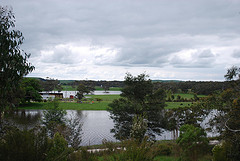
Floods can be devastating for farmers. They can also present a health risk for people and animals. Preparing your farm for flood may help to reduce some of the damage.
Make sure you have a flood plan:
- Have 1-2 weeks of non-perishable foods in stock and ensure access to clean drinking water.
- Make sure your insurance covers flood damage.
- Store important documents, photos etc. in an emergency kit that is waterproof.
- Anchor fuel tanks and relocate waste, chemicals and poisons to high areas.
- Relocate pumps to high ground.
- Store electrical tools in highest possible places.
- Know the safest routes out if you need to leave.
- Plan for flash flood and/or slow moving flood events (depending on your location)—these are likely to require different responses.
Farm animals:
- Investigate building refuge mounds with feed and water storage for livestock in flood prone areas.
- Use the flood mound during the year so animals are familiar with it.
- Relocate bulls, stallions and rams when flood alerts are issued, as they cannot be held in confined spaces with other stock.
- Prepare early to move animals with young at foot to higher ground.
Pasture and crops:
- Try to minimise planting crops in flood prone areas.
- Investigate which crops can be sown successfully after a flood.
- Floods spread weeds, so monitor and control weed growth.
After a flood, seek support, both personal and financial, to help you cope. Contact Centrelink and your local relevant government department (e.g. Agriculture Victoria; Rural Assistance Authority NSW; Department of Agriculture, Fisheries and Forestry QLD).
Floods are a potential danger for people, animals and property. Flash flooding carries the greatest risk of injury or death. Slow onset flooding can result in major livestock losses and crop damage, significant damage to roads and rail links, and isolation of rural communities. Never walk, swim or drive through floodwaters. You can prepare for floods by devising a household emergency plan. Keep an emergency kit handy and never take unnecessary risks during a flood.
Find out more about this topic on Better Health Channel.
Fast facts:
Floods – farm preparation and clean up
- Prepare your farm for flood, locate buildings on the highest ground and create artificial refuge mounds for animals.
- Have a flood plan and prepare your farm beforehand.
- Listen to local radio and monitor state emergency apps (e.g.Vic Emergency App) for updates and warnings.
- In times of flood, contact your State Department of Agriculture or Primary Industries—relief support may be available.
References used for this topic
More information:
World Health Organisation
Floods and health: Fact sheets for health professionals
Bureau of Meteorology
General Flood Information
Agriculture Victoria
Flood Resources Directory
Agriculture Victoria
Emergency Management – Floods
Department of Primary Industries (NSW)
Livestock flood refuge mounds [PDF 246kb]
VicEmergency
Incident and warnings map of Victoria
ABC Emergency
Plan for an emergency: Flood
WA Department of Fire and Emergency Services
Emergency Kits
National Emergency Management Agency
Helping Communities in Times of Emergency
Research & reviews:
NSW Environment and Heritage
Flood Risk Management Manual
Australian Disaster Resilience Knowledge Hub
Flood Emergency Planning for Disaster Resilience Handbook
Clinical Infectious Diseases
Health risks of flood disasters
|
|